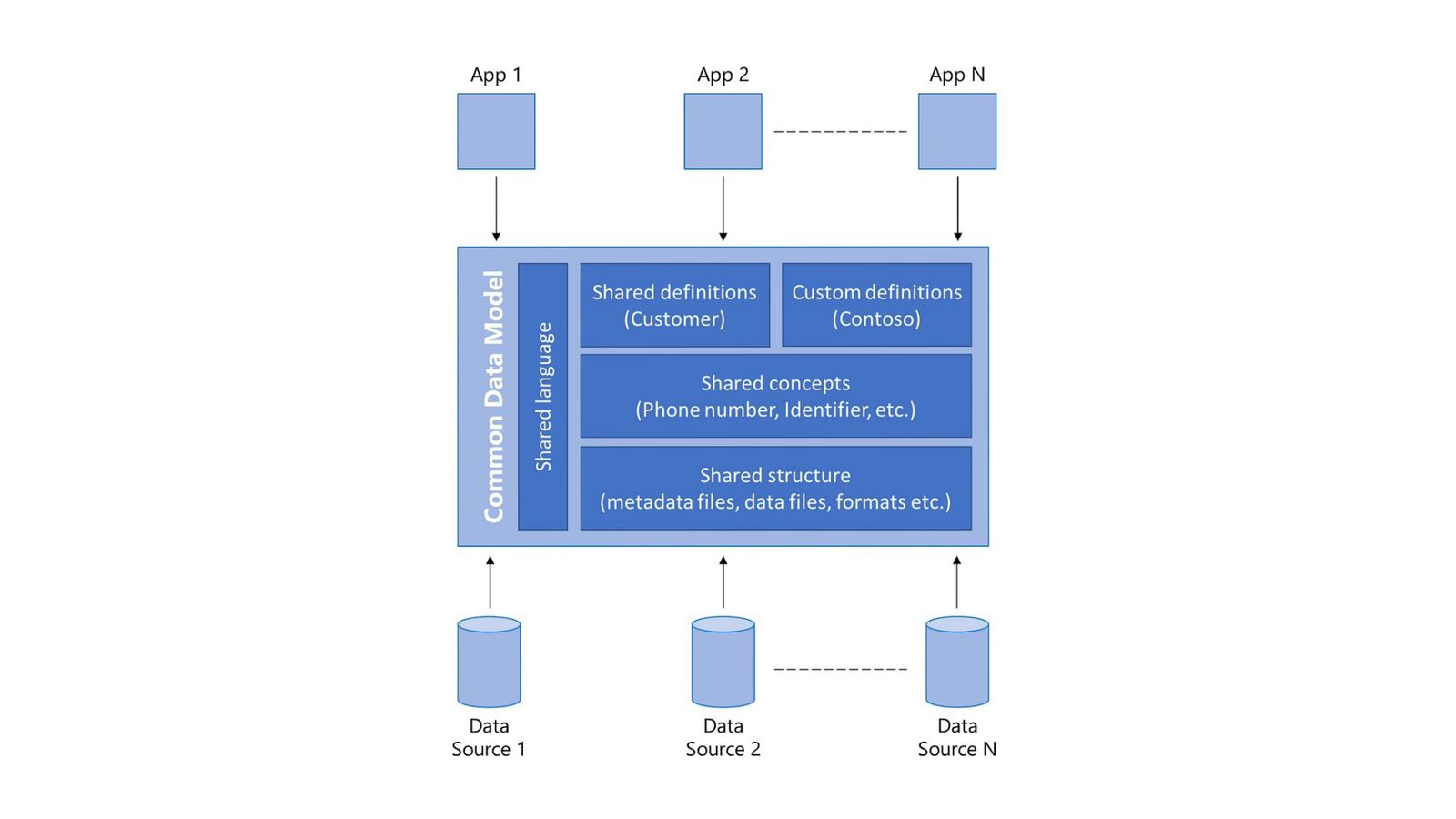Exploring Advanced Data Architectures: Common Data Model and Master Data Model🏢🚀
 Shreyash Bante
Shreyash Bante
3. Common Data Model (CDM)
Overview:
The Common Data Model (CDM) is a standardized and shared data schema that helps integrate and manage data across various systems, applications, and business processes. It provides a common framework for how data is structured, enabling seamless data exchange between systems with minimal customization. CDM is widely used in enterprise applications, especially in platforms like Microsoft Dynamics, Power Platform, and Azure, to improve data consistency and ease system interoperability. In Simple words you have multiple applications creating sort of similar data like customers, you will be generating the same columns like customer name, id , and address no matter which application is generating it.. so rather than having multiple customer tables for each application 1 simple table is utilized. But the key feature is CDM does not hold data actual data is still stored in ADLS or other storage and tables just represent structure only.
Key Features:
Standardized Data Definitions: CDM defines standard data entities such as customers, sales, orders, etc., across systems.
Interoperability: It facilitates data integration between different software platforms by ensuring consistent data formats.
Efficiency in Data Management: CDM simplifies data migration and transformation processes by using shared data models.
Use Case Example:
In a retail company, CDM can be used to integrate data from customer relationship management (CRM), enterprise resource planning (ERP), and e-commerce systems into one consistent format. For instance, the sales data collected from both in-store and online systems can be unified to generate comprehensive reports, offering better insights into customer behavior.
4. Master Data Model (MDM)
Overview:
The Master Data Model (MDM) is a framework designed to create and maintain a "single source of truth" for critical business entities such as customers, products, suppliers, and locations. MDM helps organizations ensure data consistency, accuracy, and governance by consolidating and centralizing data from multiple systems into one authoritative repository. This model is vital for enterprises looking to standardize their core data entities and avoid duplication or errors across various departments.
Key Features:
Centralized Data Governance: MDM enforces rules and policies to ensure data accuracy and consistency.
Single Source of Truth: It provides a unified view of key entities like customer or product information, ensuring consistency across systems.
Data Deduplication: Helps in reducing redundancies by identifying and merging duplicate records across multiple systems.
Use Case Example:
For a multinational corporation, MDM could be used to create a unified customer record that integrates data from regional CRMs, online portals, and third-party systems. This allows for accurate reporting, consistent customer communication, and personalized marketing efforts based on a single, up-to-date customer profile.
5. Common Data System (CDS)
Overview:
The Common Data System (CDS), often referred to as the Common Data Service in the context of Microsoft’s Power Platform, is a centralized data platform that allows organizations to securely store and manage data used by business applications. CDS serves as a database where data from multiple sources can be integrated, stored, and made accessible to various applications, providing a single platform to unify business processes and data. It supports model-driven apps and integrations with platforms like Microsoft Dynamics 365, PowerApps, and Power BI.
CDS provides standardized entities (like Accounts, Contacts, and Leads) that can be customized or extended based on the organization's needs. It offers data governance, security, and a powerful backend for managing business data.
generally speaking, this is for people who don’t know too much about databases but need some sort of storage for their applications. you can’t connect and fetch data from CDM as its just a structure but CDS is a storage and you can authenticate and pull data from it in applications like power bi
Key Features:
Standardized and Custom Entities: CDS comes with predefined entities (e.g., customers, orders) that follow industry standards, but it also allows customization to adapt to unique business processes.
Data Governance: CDS ensures that the data is stored securely and with proper role-based access, maintaining compliance and governance standards.
Business Logic: CDS supports defining business rules, workflows, and automation that operate on data within the system.
Integration: It can easily integrate with other systems and applications, like PowerApps, Power Automate, Dynamics 365, and third-party apps.
Use Case Example:
Imagine a company using different systems for customer management, sales tracking, and inventory management. CDS can act as a central repository for all these systems, ensuring that all applications share the same data. For example, if a sales rep updates customer information in Dynamics 365, the updated information is immediately available in Power BI dashboards or PowerApps applications built on top of CDS.
Key Benefits of CDS:
Data Unification: All organizational data can be stored and accessed in one central system, making reporting, analysis, and application development easier.
Security: CDS ensures that the data is securely stored, with customizable role-based security features.
Scalability: As the organization grows, CDS can scale to accommodate more data and additional business applications without performance loss.
Automation and Workflows: CDS integrates seamlessly with Power Automate, allowing users to build automated workflows triggered by changes in data.
Key Differences Between CDS and Other Data Models (CDM & MDM):
| Feature | Common Data System (CDS) | Common Data Model (CDM) | Master Data Model (MDM) |
| Purpose | Centralized platform for securely storing and managing data | Standardized model for data integration across systems | Centralizes core data entities into a single source of truth |
| Scope | Focused on managing and integrating business application data | Focused on data structure and format consistency | Focused on data governance and accuracy across systems |
| Usage | Ideal for applications using Microsoft Power Platform and Dynamics | Ideal for cross-platform data exchange | Ideal for managing critical business entities like customers, products |
| Data Governance | Strong role-based access controls and security features | Focuses on ensuring standardized data formats | Enforces data deduplication, accuracy, and compliance |
Subscribe to my newsletter
Read articles from Shreyash Bante directly inside your inbox. Subscribe to the newsletter, and don't miss out.
Written by

Shreyash Bante
Shreyash Bante
I am a Azure Data Engineer with expertise in PySpark, Scala, Python.